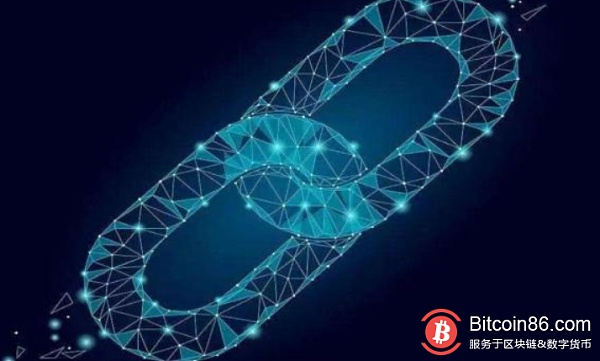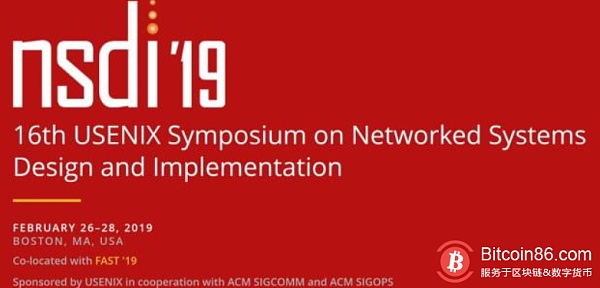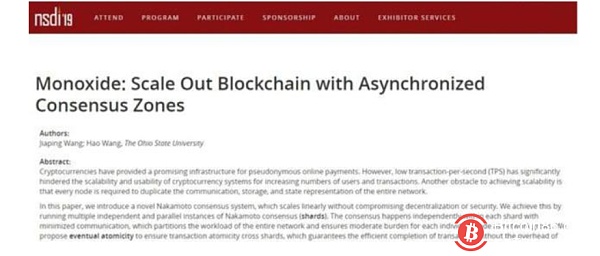China blockchain hardcore technical papers first selected for the international top conference

However, the blockchain technology that is advancing at a high speed has long faced a well-known "impossible triangle" technology bottleneck. It is also because of this problem that blockchain technology still cannot fully realize its full potential in various fields. Here, the blockchain "impossible triangle" is also called "three-dimensional paradox". It means that the blockchain network model cannot take into account the performance, security, and decentralization regardless of the consensus mechanism used to determine the new block generation method. These three requirements can only satisfy two of them and sacrifice the other one. The maximum of the three is two. In December last year, NSDI, the top computer network conference, announced the recruitment of a blockchain research paper written by Dr. Wang Jiaping and Dr. Wang Hao. The paper proposes a blockchain expansion plan called the asynchronous consensus group Monoxide, which can be used by 48,000. In a test environment consisting of global nodes, achieving 1000 times more transactions per second than the Bitcoin network and 2000 times the state memory capacity is expected to break the bottleneck of the "impossible triangle" that has long plagued blockchain performance. Dr. Jiaping was a researcher at the Redmond Institute of Microsoft Headquarters, focusing on distributed systems, computer graphics and vision, and GPU clusters for machine learning. Several dozens of research results were published in ACM SIGGRAPH/ToG. Top international journals, ten items of authorized US patents. He studied under Dr. Shen Xiangyang (now Microsoft's global executive vice president) and received his Ph.D. from the Institute of Computing Technology of the Chinese Academy of Sciences. His doctoral thesis won the 2009 National Outstanding Doctoral Dissertation Award and was the only computer science graduate in the year. .
Dr. Wang Jiaping is currently an executive director of the Innovation Workshop. His investment direction is blockchain and artificial intelligence. He has led the first round of institutional investment in Bitcoin and became one of the three major investors in his first round. It is worth mentioning that the authors of the paper, Dr. Wang Jiaping and Dr. Wang Hao graduated from the Institute of Computing Technology of the Chinese Academy of Sciences. The Institute of Computing Technology of the Chinese Academy of Sciences is also one of the joint authors of this paper. In the future, the Innovation Workshop will also carry out more in-depth technical and industrial cooperation with the Institute of Computing Technology of the Chinese Academy of Sciences. China's blockchain technology papers were selected for the first time in the international summit. This is the first article in the blockchain field where Chinese people were selected for international top conferences. NSDI, the full name of Networked Systems Design and Implementation, is one of USENIX's flagship conferences and a prestigious conference in the field of computer networking systems. Compared with other top academic conferences in the same field, NSDI is more focused on the design and implementation of network systems, focusing on system performance and scalability. The famous big data system Spark was published in the 2012 NSDI conference. NSDI has always been known for its emphasis on the quality of articles, and it has adopted a rigorous double-blind review. Each article has to be reviewed by two to eight reviewers in two rounds, after which it has to be reviewed by the program committee. Usually, more than 20 papers are accepted at each session, and the admission rate is only about 25%.
- In 2018, Australian encryption-related fraud reports rose by nearly 200%
- Galaxy Digital's loss expanded to 272 million US dollars, the founder crazy shouting is to find the pick-up man?
- V God proposes a shareholding certificate to ensure the safety of the Ethereum blockchain

The research topics of NSDI focus on computer networks and distributed systems, and the core technology of blockchain belongs to this field. However, in fact, the current mainstream research direction in this field in academic circles is still focused on the theoretical challenges and practical engineering problems in centralized data centers, super-computing centers, and most of them are cloud computing industry and machine learning involving a large number of computing tasks. field. This time, Dr. Wang Jiaping and Dr. Wang Hao's paper "Monoxide: Scale Out Blockchain with Asynchronized Consensus Zones" broke into NSDI 2019, which is the first time that the international mainstream academic community has approved the blockchain expansion plan. The only paper on the blockchain related to the admission was also the first article in the field of China's selection of blockchains. It can be described as "the light of China."

Breaking the blockchain is unlikely to be a triangular bottleneck. The significance is comparable to the deep learning technology breakthrough. The AI is restricted by the "impossible triangle". The early blockchain network is usually a single-chain form. In order to balance security and decentralization, Making performance sacrifices – if the process of processing the task of the blockchain network is analogized to the process of people going to the ticket hall to buy tickets, then the single-chain blockchain can be seen as only one ticket window in the entire ticketing hall, all before All the people who buy tickets must line up outside this window, so the ticketing speed of this ticketing hall can be imagined, and the number of tickets sold in the unit time is naturally not ideal. The emergence of the Monoxide model breaks this bottleneck. Under the premise of satisfying the triangulation of safety, high performance and decentralization, no additional entities are introduced and no additional mechanism is introduced. So how is this achieved? First, replace the single chain with multiple chains, in other words, add a window to the ticketing hall. In fact, some studies have tried multi-chain models before, but they can't work together in isolation, and they can't really realize the potential of "multi-chain". It can be understood that there are multiple windows added to the ticket hall, but one destination only corresponds to one window. That is to say, the person who comes to sell the ticket cannot successfully buy the ticket in the "no match" window, but needs to buy the ticket according to the destination to the corresponding window. This means that at the same time, some windows will line up in front of the window, and some windows may be empty before. The number of tickets sold in the entire ticketing hall in the unit time is still limited, and the ticketing efficiency is still greatly improved. space. The Monoxide network is a concurrent multi-chain system, and each chain is called the "consensus group", which is the essence of it. Specifically, the consensus group consists of multiple homogeneous, functionally identical, fully equal, and logically isolated, independent consensus systems that work in parallel to share the throughput and computing of the entire network. The storage pressure and the maintenance work of the whole network state. Since the consensus groups are completely parallel and asynchronous, there is no need to lock and synchronize. Therefore, even if one consensus group is congested, it will not interfere with the throughput and the outbound of other consensus groups. In this way, in the ticketing scenario described above, each person who comes to the ticketing hall to buy a ticket can buy the ticket directly in any window, and the ticket sellers in different windows will play a role in the background to make the unit time to sell. Maximize the number of tickets. In terms of performance, the throughput and capacity of the blockchain will increase significantly, that is, the number of tickets sold per window per unit time and the number of people in the ticket hall per unit time will increase significantly. Experiments show that the Monoxide model can extend an existing single-chain consensus algorithm by more than 1000 times, which can increase the throughput by more than 1000 times, and also increase the network computing power (CPU) by more than 2000 times. The memory space has increased by more than 2000 times. In theory, the upper limit of the horizontal expansion can even reach the order of 100,000. This research result undoubtedly brought a qualitative leap to the development of blockchain technology.

Wang Jiaping revealed that in August 2019, Monoxide will go online to test the network for developers to do technical evaluation.
Landing applications are just around the corner, and practical scenarios such as financial payment, medical care, and smart cities will be in place. The application and popularization of blockchain technology has received much attention. Due to the huge potential of this technology in terms of efficiency improvement and security protection, more and more industries are beginning to recognize the power of the blockchain and gradually try to land. The introduction of the Monooxide Asynchronous Consensus Group system has made blockchain technology a step further in practical application. Since the development of the Internet, any real online application needs to carry a large amount of daily access and operations as well as record the status and information of a large number of users. This has led to the application of any blockchain technology, which requires the blockchain technology itself to be able to carry such traffic and user volume. This is why the performance of the blockchain technology itself is critical to the practical application of the application. The Monoxide Asynchronous Consensus Group system achieves performance improvement without sacrificing decentralization. The operating pressure (bandwidth, computation, memory, disk IO) of each node is not significantly increased with the horizontal expansion of the entire network. In this way, it is of great significance to ensure that a computer with a common mid-range price can easily serve as a full node of the network and access the main network through an ordinary home broadband network, which is an important contribution to the advancement of the blockchain technology. For example, in the past, in the field of financial payment, subject to currency exchange, formalities and other factors, cross-border payment often requires high time costs and is difficult to complete efficiently. With the help of blockchain technology with open and non-tamperable attributes, the credit mechanism of both parties will be guaranteed, and the system's operational efficiency will be greatly improved, business costs will be reduced, and cross-border payment will be effectively promoted in the commercial field. . In the same way, blockchain technology is also promising in areas such as bank clearing, supply chain management, and commodity anti-counterfeiting. It even has the opportunity to bring subversive reforms. In addition, in the field of artificial intelligence supported by massive data, the potential of blockchain technology also has a great space for display. Data security is one of the hot topics and pain points in the artificial intelligence industry. Blockchain technology, by virtue of its own decentralization and anonymization, can not only ensure the security and privacy of data sharing in the field, but also avoid data islands. The situation has happened. This combination of blockchain technology and artificial intelligence technology can provide more possibilities for smart cities, health care, food safety and other fields.
Source: Network
We will continue to update Blocking; if you have any questions or suggestions, please contact us!
Was this article helpful?
93 out of 132 found this helpful
Related articles
- Bitcoin Bubble Autopsy Report
- There are at least three ways to completely destroy Bitcoin.
- Russia begins cryptocurrency technology test
- Bitcoin can't be the future of cryptocurrencies?
- European opinion poll results: Bitcoin will be replaced within 10 years
- Used cars are refurbished, consumption is opaque… Can the blockchain solve the problem of car fraud?
- The future of the banking industry is on the blockchain?





